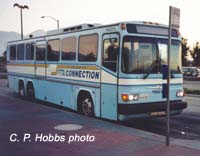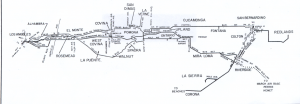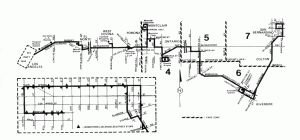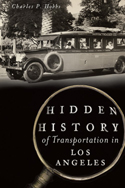It used to be a lot easier to get from Los Angeles to Riverside or San Bernardino than it is now.
RTD #496, and its predecessor #60 connected Los Angeles and the San Gabriel Valley with the Inland Empire. Just hop on the bus, and within a couple of hours, you’d be some sixty miles away. No transferring, no trouble.
Story of a long route
The history of these routes can be traced all the way back to the interurban “stage” buses of the early 1910s. Truston Clark ran a bus line from Los Angeles to San Bernardino and Redlands via Ontario, while the A.R.G. Bus Co. operated over a similar route to Riverside. These bus lines competed with the Pacific Electric route from Los Angeles to San Bernardino, although the rail line operated along a more northerly route.
In the early 1920s, O.R. Fuller’s Motor Transit took over the Clark and A.R.G. bus lines and operated them from a depot at Los Angeles and Sixth Streets, downtown. These buses used Valley Boulevard between Los Angeles and Pomona, making good time along the relatively lightly trafficked road.
Between 1929 and 1933, a series of mergers and acquisitions left Motor Transit under the control of Pacific Electric. In a cost saving move, PE began to replace certain passenger rail lines with bus service. As the Los Angeles-San Bernardino rail line was cut back in the 1940s, a new bus route running along Foothill Boulevard went into service. When PE numbered its bus lines, this complex of routes received several numbers before eventually being designated #60.
Taking it to the freeway
As the San Gabriel Valley developed, travel along Valley Boulevard became increasingly slower. However, the San Bernardino Freeway had opened in the early 1960s. In 1964, the #60 was rerouted to use the freeway. A new local route, #53, served Valley Bl. between Los Angeles and Pomona.
#60 ran express to Pomona; then it split into three routes. #60E continued to Riverside before veering north to San Bernardino via Colton. #60F was the express version of #60E; it spent more time on the freeway and made only limited stops. #60G left Pomona for Claremont, and then continued through the foothill communities of Upland, Fontana and Rialto to San Bernardino.
This service pattern operated until 1973. That year, the bus company, now known as the Southern California Rapid Transit District (RTD) asked the surrounding counties to help pay for the bus service. San Bernardino County refused, so RTD cut back the #60G to Upland. San Bernardino County replaced the Upland-San Bernardino portion of #60G with a new service, named “East Valley Transit.” (When Omnitrans came into being in 1976, this route became its #14.)
The birth of the #496
Development continued throughout the San Gabriel and Pomona Valleys, and traffic increased to the point that RTD needed to reconfigure service again. In April 1976, RTD replaced the venerable #60 with two new lines. #480 would operate along the San Bernardino Freeway to Pomona, providing local stops along its route. #496 would operate along the freeway to Riverside and San Bernardino. Interestingly, while #496 would make stops in Los Angeles County cities (El Monte, West Covina, Pomona), it would only carry passengers destined to either Sa
n Bernardino or Riverside County. Los Angeles County-only passengers were usually told in no uncertain terms to take the #480, although an occasional sympathetic driver on a late night #496 might carry a passenger to Pomona Park-Ride after the last of the commuter buses had left Downtown LA for the evening.
For the next fourteen years, #496 made its rounds between Los Angeles and the Inland Empire, with only a few minor changes made to the route (most notably, service in downtown Pomona was dropped, and buses only stopped at the Pomona Park-Ride lot).

Inland Empire Connection bus
The Inland Empire Connection
As the end of the 1980s approached, transit agencies started to consider contracting with private bus companies to provide service at a lower cost. (The private companies saved cost by paying drivers less than the public operators did). In Southern California, “Foothill Transit” and “Commuter Express,” both of which contracted with private operators, had both begun service in late 1987. These new bus operations attracted riders who had formerly shunned RTD buses.
In 1990, the transit agencies of Los Angeles, Riverside, and San Bernardino County decided to turn the #496 over to a private contractor. By August 20 of that year, the red-and-orange striped RTD buses had been replaced with the large blue coaches of the “Inland Empire Connection” (IEC), a joint effort of the three transit commissions. Since the operating cost of the service was about half that of RTD, there was enough money for a second route. This new route, dubbed #110, operated directly along the freeway between Montclair and San Bernardino; passengers destined to/from San Bernardino no longer had to swing through Riverside along the way. Jointly, IEC #110 and #496 provided service every 30 minutes between Los Angeles and Montclair. As with the RTD-operated #496, neither bus carried passengers entirely within Los Angeles County.
The beginning of the end
About three years later, the Los Angeles County transit agency, now known as the Los Angeles Metropolitan Transit Authority (MTA), began to rethink their involvement with IEC. Financial difficulties were causing the MTA to consider cutting service and raising fares. Also the Metrolink commuter rail system now carried commuters from San Bernardino and Riverside, causing IEC ridership to drop. By October 1993, MTA reduced funding for the IEC by half. This meant that the #110 and #496 would operate only every other trip west of Montclair to Los Angeles. In June 1994, MTA had cut all IEC funding and buses traveled only as far as Montclair. Passengers continuing further westward were forced to transfer to MTA, Foothill Transit, or Metrolink.
Next, Riverside County decided to pull support for the IEC, in favor of its local services.
In July 1995, the Riverside Transit Agency (RTA) started a new route, #49, over #496’s Mission Blvd route segment. between Riverside and Country Village (a large retirement home just north of the Pomona Freeway). #496 continued to run to Riverside, but during peak hours only via the freeway. Midday riders had to transfer between the #496 and #49 at Country Village. Occasionally the #496 would miss its connection with the last #49 leaving Country Village, stranding passengers.
Omnitrans also decided to focus its resources on local transit. In January 1997, Omnitrans dropped funding for #496, and started a new route, #71 between Montclair and Country Village. (The bus agency decided to keep the #110, which operated entirely in San Bernardino County.) #71 was a local, surface-street route, taking longer than the freeway-express #496. That meant that not only did passengers still have to transfer, but their trips took longer.
Since #71 also ran weekdays only, the Riverside County Transportation Commission funded weekend-only service on #496 during 1997. As RTA seemed uncommitted to reinstating the #496, RCTC considered contracting with Foothill Transit to provide the service. But no agreement with Foothill could be reached. Meanwhile, all the cutbacks and other changes to #496 had caused ridership to plummet.
As the last #496 completed its trip in January 1998, RCTC chairman Bob Buster, contemplating the slow dismantling of what had been a productive bus route, remarked, “Los Angeles is like a modern-day Roman Empire, and Rome takes care of itself first and the provinces last.”
Express service between Riverside and San Bernardino (IEC #100) still operated, and passengers from Montclair could still use IEC #110 to San Bernardino, then transfer to #100 for the trip to Downtown Riverside. But this was still a longer trip than the former #496. #110 continued to operate, with a few stop changes (Ontario Airport was dropped, while new stops at Ontario Mills Mall, Kaiser Hospital Fontana and the Arrowhead Regional Medical Center were added), until July 2007. At that point, Omnitrans cut the Montclair-San Bernardino portion, leaving only the segment between Riverside and San Bernardino as the last remnant of what had been an extensive complex of bus routes operating between Los Angeles and the Inland Empire for over ninety years.
The return of 496…well, sort of
On September 2, 2003, RTA implemented four new long-distance express bus routes. These services, dubbed “Commuterlink,” were marketed toward business commuters. Commuterlink #204 operates between Riverside and Montclair on a route very similar to that of the old #496. In 2008, RTA extended #204 to the UC Riverside campus in an attempt to increase ridership.
Nowadays, if you can use #204, it is possible to get to Riverside easily. But #204 is strictly a peak-hour, weekday only service. Another alternative is Metrolink, but its reverse-commute trains are nowhere near as frequent as the old #110 and #496. Also, because the Riverside and (particularly) the San Bernardino stations are some distance from the downtown areas, prepare to walk or take a local bus to get to your destination.
Or, piece together local bus trips on Omnitrans and RTA, and hope the connections work out well…
References:
Bail, Eli, From Railway to Freeway: Pacific Electric and the Motor Coach.
“Expedited Service to Come on Lines 60 and 63 June 14.” MTA Emblem, May 1964, p. 9
Transit Advocate, July 1996, p. 3 (http://www.socata.net/advocate9607.pdf)
Pund, Ernest E. “Bus Route 496 rolls to LA for last time.” Riverside Press-Enterprise, January 29, 1998.
Welsh, John. “New buses to serve longer routes.” Riverside Press-Enterprise, June 26, 2003.
Western Transit (newsletter of the Western Transit Society), as appropriate
Bus schedules, maps, agency agendas, etc. as appropriate
Comments and corrections welcomed. Some details was necessarily left out or glossed over.



And yet there’s still more happening on that route. 🙂
In 2003, Omnitrans consolidated #100 (San Bernardino-Riverside) with #90, a freeway express that looked much like the 60C route, but via I-10, with stops at Montclair, Ontario Mills Mall, south Fontana, Arrowhead Medical Centre, and downtown San Bernardino. The resulting route was named the #90 and ran all the way from Montclair to Riverside- I rode it very often, as my then-girlfriend (now my wife of 5 years) lived in Ontario and I lived in Riverside. It ran all day, every day, so it was the slower alternative to #204, which we rode when we could.
In 2008, Omni pulled the I-10 portion of the route, leaving that corridor served by local buses and Metrolink alone. (BIG mistake IMHO- it is a serious chore to get from San Bernardino to the LA county line.) The 14 and 66 locals provide service along Foothill between SB and Fontana, and Fontana and Montclair, but the ride gets VERY long. The remaining express service is now called the 215, running along I-215 from Riverside to San Bernardino, with a stop in Colton. Some of the signs still carry Inland Empire Connection logos.
Also, the RTD 149 served an LA-IE market, Long Beach to Riverside via Orange County. I don’t know all the details, but it was similarly absorbed by the Inland Empire Connection, and has been curtailed to run Riverside-Orange via SR-91 and the Express Lanes. The sign for the bus at Tyler Mall in Riverside still carries the IEC logo.
By the way, welcome to the RiR blogroll. Keep up the good work.
Fine paper — thanks for putting this history in writing so that it will not be forgotten.
A few minor points:
1. Although the Foothill Transit Zone had been in the works for many years, it didn’t actually start transit service until the early 1990’s due to disputes between SCRTD and LACTC. LACTC was pushing the Zone as a money-savings measure in the constant battles between the two, and while the threat of cutting off funding to SCRTD — they actually did stop the payments for a few months in late 1988 — led to a “compromise” brokered by then-Mayor Bradley, the next step was the various SCRTD unions going to court to prevent what amounted to the loss of their jobs.
(LACTC thought that it had SCRTD right where it wanted it after it passed a resolution that all labor contracts signed after June 30, 1988 could NOT have any COLA adjustments, or no money from LACTC. SCRTD and the labor union attorneys actually read the new requirement — and realized that a contract that was actually signed on the very last day of the existing contract, June 30th, would not be signed AFTER June 30th, so the money would still flow. I’m not sure if LACTC staff and Board were more embarassed by leaving such an obvious loophole or they were more mad that they would be delayed years before they could pull the plug.)
It took a while for the Union challenge to be worked through the courts and for FTZ to be finally given “ownership” of the bus routes. For the first week or so, we had both SCRTD and FTZ buses running the same routes at the same time, because before SCRTD could stop service on a line, there were various legal steps that had to be taken and, after waiting so long, FTZ was going to start immediately, no matter what.
One major factor on this that you won’t see anywhere was the very large number of SCRTD employees who lived out the San Gabriel Valley and beyond and who took these routes to work — with a “ride free” SCRTD employee pass, of course, which FTZ did not honor.
One of these people worked maintenance on the graveyard shift at what was then Division 5, which was taken over by the National Guard when the Rodney King Verdict Riots occurred. He had heard nothing about this, so he rode in as he usually did, mid-afternoon, then found that the bus he took to his work site was not running because SCRTD had been told to pull all the service off the street. So, he walked about five miles through the heart of the riot zone to get there, dodging both mobs of rioters and police patrols — and then went up to his boss to appologize for being late. His boss told him, “I don’t know whether to put you up for employee of the month or to buy you a radio so you can follow important news,” — so they both.
Thanks for the fine comments, guys. I did gloss over a few details just to keep the article from becoming too long/detailed.
Re: Foothill: There were “Foothill Transit” buses operating as early as November(?) 1987 (#492 and #494 commuters, shortly followed by the Pomona locals in December). But these were actually LA County buses, operating with Foothill equipment. Foothill Transit as such existed, but went through all the above details before it could officially operate.
Thanks for the memories. I remember riding out on the 496 all the way to San Bernardino sometime around 1977 or so when I was about 12.
Rode on one of the 3000 series GM fishbowl suburbans. At the time the RTD was still using the old Greyhound station in San Bernardino.
I remember the RTD 60 line from the 1960’s. It was one of the last local bus lines to use manual-transmission buses: 2000-class GMs and later 5600-class Flxibles, both equipped with baggage rack and possibly underfloor luggage. Since I lived in the northern San Gabriel Valley (Duarte), I had another way to get to San Bernardino: the Greyhound run that stopped in Azusa. The only catch was that one had to buy a ticket to Calimesa, the first stop outside of RTD country, because of the General Southern California Restriction.
Not sure (it was back around 1976) but I think it was the RTD 480 line that had the double-deckers in that era. I took one of my daughters for a ride on one, “just for the heck of it” and noted the different atmosphere of the upper deck–none of the “transactions” that are part of riding on a regular bus.
Is there still any bus schedules left or saved from the IEC 100,110 and 149 and RTD line 496 if so are they available for viewing online or at the Metro Library?
The late Edmund A. Buckley (1943 – c.2016/17) rode every bus line the Los Angeles Metropolitan Transit Authority (LAMTA) operated c. early 1960s, kept a diary about that featured in an LAMTA EMBLEM in-house publication, exactly a decade later I’d ride ~75% of regularly scheduled bus lines the Southern California Transit District (SCRTD) operated including the Line 60 group except the 60-E & Redlands/Yucaipa service, didn’t keep a diary alas. From 1968 on SCRTD operated mix of 2000 & 3000-series GMCs, 5600 Flxible mechanical shift buses on the Line 60 group myself riding on 3000-3014 S8M-5303As. I may be one of few people left who’d ridden many SCRTD bus lines going back to the nineteen-teens, alas didn’t ride Lines 84 Western & 85 – Crenshaw-Vine-La Brea, still smart over that!